|
|
|
Sort Order |
|
|
|
Items / Page
|
|
|
|
|
|
|
| Srl | Item |
| 1 |
ID:
130074
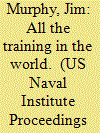

|
|
|
|
|
| Publication |
2014.
|
| Summary/Abstract |
My opinion has not changed-although my explanation might-and this is an issue that continues to plague the armed forces. The Navy has even embraced sub-themes for Sexual Assault Awareness Month (SAAM); for the first half of April, the message is "Live Our Values." That was my intended meaning: Sexual assault is contrary to our core values.
My friend's criticism was part of a cordial, yet emotionally driven discussion, and it was enlightening. It was accompanied by the story of a young sailor who faced blatant sexual harassment from her leading petty officer.
That sailor was subjected to repeated inappropriate comments in public, and more graphic comments in smaller groups. These remarks were overheard by a chief petty officer who asked the junior sailor if she wanted him to talk to the petty officer. Harassment and assault are two very different things, but a lax attitude toward the former diminishes an atmosphere of respect, the overarching theme of SAAM 2014.
|
|
|
|
|
|
|
|
|
|
|
|
|
|
|
|
| 2 |
ID:
130063
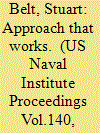

|
|
|
|
|
| Publication |
2014.
|
| Summary/Abstract |
When it comes to solving problems with China's overreach at sea, there are laws for that.
|
|
|
|
|
|
|
|
|
|
|
|
|
|
|
|
| 3 |
ID:
130071
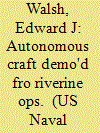

|
|
|
|
|
| Publication |
2014.
|
| Summary/Abstract |
Swiftships competes in global markets for smaller naval ships. The company has delivered 13 120-foot coastal patrol boats to the Iraqi navy under a 15-ship contract and has a long-term agreement with the Egyptian navy to co-produce 25-foot patrol boats in Egypt. It also has built ships to support offshore drilling operations for U.S. and international oil and natural-gas companies.
|
|
|
|
|
|
|
|
|
|
|
|
|
|
|
|
| 4 |
ID:
130062


|
|
|
|
|
| Publication |
2014.
|
| Summary/Abstract |
Although their economy is increasingly dependent on maritime trade, China lacks the ability to protect its shipping-a dangerous reality should they find themselves in a major war at sea.
China's greatest strength is at the same time its greatest weakness. With the second largest global economy, about 60?70 percent of China's economic activity today is directly or indirectly linked to trade with other nations. 1 In 2011 85 percent of China's total trade was by sea. 2 In this regard, the country is increasingly dependent on maritime trade-and the security of its sea lanes-for its economic vitality, high standard of living, and military strength.
|
|
|
|
|
|
|
|
|
|
|
|
|
|
|
|
| 5 |
ID:
130061
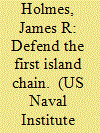

|
|
|
|
|
| Publication |
2014.
|
| Summary/Abstract |
A strategic solution to the troubled waters of the Western Pacific is perimeter defense-but what kind? History offers options.
Want to give China an ulcer, a nagging sore that compels Beijing to think twice about aggression? Then look at the map. Geography affords the U.S.-Japan alliance abundant opportunities to make trouble for the People's Liberation Army (PLA), denying China's military access to the vast maneuver space of the Western Pacific while hampering its movements up and down the Asian seaboard. Fortifying the offshore island chain while deploying naval assets in adjoining waters could yield major strategic gains on the cheap. Doing so is common sense. The only question is how.
|
|
|
|
|
|
|
|
|
|
|
|
|
|
|
|
| 6 |
ID:
130060
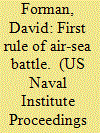

|
|
|
|
|
| Publication |
2014.
|
| Summary/Abstract |
When it comes to the much-discussed concept, misconceptions abound; the first thing to fix may be the nomenclature itself.
If there were a first rule of Air-Sea Battle (ASB), it should be: "Do not talk about Air-Sea Battle." The cloud of confusion and criticism surrounding the concept is undermining this Department of Defense 21st-century warfare initiative. When the world's only superpower announces something called "Air-Sea Battle ," the rest of the world listens, and the DOD must get it right. Failure to correct current misunderstandings about the idea could lead to unintended and unwanted consequences counter to U.S. strategic interests. It is time for Air-Sea Battle 2.0, and step one is changing the name.
|
|
|
|
|
|
|
|
|
|
|
|
|
|
|
|
| 7 |
ID:
130064
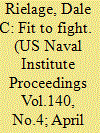

|
|
|
|
|
| Publication |
2014.
|
| Summary/Abstract |
Despite Western skepticism, all signs point to a Chinese navy that is skillfully tackling surface-force maintenance challenges.
In 2013, the Chinese People's Liberation Army Navy (PLAN) commissioned 17 new battle force surface ships. 1 These units continue the transition of the PLAN surface order of battle from smaller, Soviet-pattern warships to modern, multi-mission platforms capable of extended deployments. As impressive as these vessels appear, naval professionals are acutely aware that platforms and payloads only represent real capability if they are functioning and available for rigorous training and real-world operations. Modern and sophisticated combatants present complex maintenance challenges that must be addressed if their technological advances are to be anything more than promise and potential.
|
|
|
|
|
|
|
|
|
|
|
|
|
|
|
|
| 8 |
ID:
130069


|
|
|
|
|
| Publication |
2014.
|
| Summary/Abstract |
The proliferation of transportation-related technology and maritime users has created an opportunity to provide mariners with a whole new way of operating. U.S. waterways are shared by people who have a wide range of experience, training, and technology, from licensed commercial operators with years of experience, electronic charts, global positioning systems (GPS), radios, and radar, to unlicensed recreational boaters venturing on the water for the first time with little more than a handheld foghorn and a cellphone. While this diversity creates an imbalance that can threaten everyone's safety, all mariners have knowledge that could benefit the well-being of all if effectively shared in real time.
The real-time sharing of maritime operators' individual knowledge, combined with other sources of relevant information, creates an enhanced state of situational awareness we call "mariner situational awareness." This is the tactical cousin of "maritime domain awareness," which has come to represent a more strategic, wide-area, and therefore less time-critical awareness of the vast maritime domain. In today's complex maritime operating environment, rife with both safety and security risks, it is critical that we develop a system where maritime situational awareness is synchronized and shared across the full expanse of maritime users.
|
|
|
|
|
|
|
|
|
|
|
|
|
|
|
|
| 9 |
ID:
130066
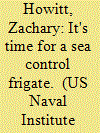

|
|
|
|
|
| Publication |
2014.
|
| Summary/Abstract |
A vessel based on the national security cutter could offer significant benefits to the Navy.
W hile O liver Hazard Perry- class frigates are not the only platforms you would want for a serious confrontation, they are great independent-deployers and effective at a multitude of missions such as escort operations and antisubmarine warfare (ASW). As the Navy decommissions the last 15 frigates, soon to be joined by 21 Ticonderoga- class cruisers, we will call on our existing hulls to support their ongoing missions. There is little doubt the littoral combat ship (LCS) fills some of this void, but even the top brass seem to agree that it's ineffective in a high-endurance, blue-water setting.
In January, a report from the Pentagon described a plan to cut the amount of LCSs from 52 to 32 ships, and in a leaked classified memo, Commander of Naval Surface Forces Vice Admiral Tom Copeman called for a new type of multi-mission ship. 1 Many envision a new combatant ship that incorporates air- and missile- defense radar and an electromagnetic railgun. While it is imperative that the Navy build these types of ships, a multibillion-dollar warship juggernaut is simply unnecessary when a new, cost-effective frigate could effectively accomplish the same missions.
Of the many potential frigate designs, Huntington Ingalls Industries offers one derived from its successful national security cutter (NSC) hull dubbed the "patrol frigate," originally intended and modeled for international navies. At first, it may seem preposterous to paint a Coast Guard cutter gray and call it a warship. In the July 2013 issue of Proceedings , Norman Polar opined that more frigates were needed, but was quick to dismiss a patrol frigate as a viable option. He claimed it "lacked growth potential and service life, as well as certain military features." 2 But tweaking the NSC could turn it into a viable candidate that meets the Navy's needs.
|
|
|
|
|
|
|
|
|
|
|
|
|
|
|
|
| 10 |
ID:
130072
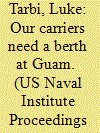

|
|
|
|
|
| Publication |
2014.
|
| Summary/Abstract |
In part, congressional inaction may be the reason. While it's up to the White House and the Departments of State and Defense to craft the overall strategy, Congress funds the key initiatives that underpin its successful execution. Guam sends only one non-voting delegate to the House of Representatives, making it unlikely that military construction on the island receives the same level of attention as do the job-creating projects in the 50 U.S. states.
|
|
|
|
|
|
|
|
|
|
|
|
|
|
|
|
| 11 |
ID:
130070


|
|
|
|
|
| Publication |
2014.
|
| Summary/Abstract |
Far-reaching consequences from declining Defense budgets will take years to overcome. Given a scenario in which U.S. capabilities have waned against the march of new threats, what should be done to mitigate the risks associated with a smaller force? What parts of current military framework should be preserved or reinforced to retain our warfighting potency? Emboldened with an economic system that rewards ingenuity, Americans look to technology to solve problems. The inclination to reach first for hardware solutions certainly has merit. The tools and networks of commerce that have emerged since our founding have altered the socioeconomic landscape and fueled an insatiable appetite for material goods. But narrow-minded materialistic thinking can foreclose opportunities and even impair national security.
|
|
|
|
|
|
|
|
|
|
|
|
|
|
|
|
| 12 |
ID:
130059


|
|
|
|
|
| Publication |
2014.
|
| Summary/Abstract |
The U.S. Navy needs a comprehensive, cost-effective, and sustainable plan to develop and deploy more regional experts to the Asia-Pacific region.
The Navy is at the forefront of the U.S. rebalance toward the Asia-Pacific region, a fundamentally maritime domain with contested global commons. This "pivot" builds on decades of a strong regional presence and long-standing alliances and partnerships with countries in the vicinity. To be effective, however, the rebalance must incorporate "brains" in addition to "brawn." While the Navy has strengthened its presence in the Pacific by increasing its rotational force deployments, basing more ships and aircraft forward, and fielding new capabilities, its efforts to enhance its intellectual capital are still underreported, under-resourced, and too often undervalued. But this is beginning to change, due in large part to the efforts of the staff of the Office of the Chief of Naval Operations.
|
|
|
|
|
|
|
|
|
|
|
|
|
|
|
|
| 13 |
ID:
130058
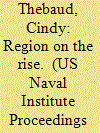

|
|
|
|
|
| Publication |
2014.
|
| Summary/Abstract |
The United States must continue to build relationships with countries in Southeast Asia, one of the world's most vibrant maritime areas.
Like the United States, Southeast Asia is a region whose destiny will be shaped by the seas that surround it. In a very real way, a Thai fisherman, an international businessman from Kuala Lumpur, a dockworker in the port of Los Angeles, and a young American naval officer deployed to Singapore are all bound together: They're among the hundreds of millions who work, live, and operate along the waterways of Southeast Asia.
|
|
|
|
|
|
|
|
|
|
|
|
|
|
|
|
| 14 |
ID:
130067
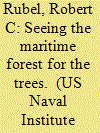

|
|
|
|
|
| Publication |
2014.
|
| Summary/Abstract |
In this article, the author ponders on a strategy document that will be released by the U.S. Navy in 2014, succeeding a 2007 document titled A Cooperative Strategy for 21st Century Seapower (CS21). Topics discussed include the prospects for a congressional deal on the defense budget that was discussed during a U.S. Naval Institute conference in 2013 and the features of Eurasian continental powers. Also mentioned is the correlation between continental powers and maritime strategy
|
|
|
|
|
|
|
|
|
|
|
|
|
|
|
|
| 15 |
ID:
130073


|
|
|
|
|
| Publication |
2014.
|
| Summary/Abstract |
Currently most IDC officers enter through the surface-warfare officer (SWO) option or lateral transfers from unrestricted-line training in aviation, special warfare, or nuclear-power school. This model is currently working well for the IDC, as it values Fleet warfare experience. However, it is a zero-sum game. Among unrestricted-line communities, surface in particular is negatively affected by the IDC SWO option, because for every officer who joins the IDC, one less is available to fill an unrestricted-line billet.
|
|
|
|
|
|
|
|
|
|
|
|
|
|
|
|
| 16 |
ID:
130068


|
|
|
|
|
| Publication |
2014.
|
| Summary/Abstract |
The Independence -class littoral combat ship (LCS) has a fundamentally different design from any other ship in the Navy. Understanding how its design affects propulsion, sea-keeping, and reactions to external forces is critical to understanding how to drive it effectively, efficiently, and safely.
The Independence -class LCS is propelled by four steerable water jets (WJs) that have independent drive trains. The two outboard WJs, driven by motor turbine union 20-cylinder main propulsion diesel engines (MPDE) rated at 12,200 horse power (HP) each, have the most impact on low-speed precision maneuvering due to their position off centerline. The two inner WJs, used for high-speed operations and restricted maneuvering situations, are driven by LM2500 gas turbine engines, each with speeds up to 29,500 HP. The ship develops thrust as water is drawn through intakes under the hull, travels through each WJ tunnel, and is driven at high speed through the WJ by an impeller.
Attached to each WJ is a hydraulically actuated reversing plate commonly referred to as a "bucket," which controls the amount of water directed forward or aft. When the ship's control console (SCC) indicates zero percent bucket, roughly one-third of the water is directed astern and two-thirds are directed forward and down, causing the applied longitudinal forces to cancel out. Even at this "zero-thrust" point, the impellers are still turning at idle speed, an important consideration for the effects of engine wash on surrounding vessels and structures.
|
|
|
|
|
|
|
|
|
|
|
|
|
|
|
|
| 17 |
ID:
130065


|
|
|
|
|
| Publication |
2014.
|
| Summary/Abstract |
China is deploying an ocean-floor surveillance network to strengthen its antisubmarine-warfare capability.
As China's naval modernization program has shifted into high gear in recent years, numerous defense analysts, both inside and outside China, have rightly pointed to the People's Liberation Army Navy's (PLAN's) quite obvious weaknesses in antisubmarine warfare (ASW) as a persistent Achilles' heel of the evolving force. Although the 2012 introduction of the Type 056 light frigate, which has subsequently been produced at an unusually rapid clip, may represent a significant step toward increasing ASW prowess, there appears to be a long road ahead for Chinese development in this realm. This is made more likely given the profound paucity of operational experience in the PLAN, as well as the apparently long-time neglect of maritime-patrol aircraft and ship-borne helicopters.
|
|
|
|
|
|
|
|
|
|
|
|
|
|
|
|
|
|
|
|
|